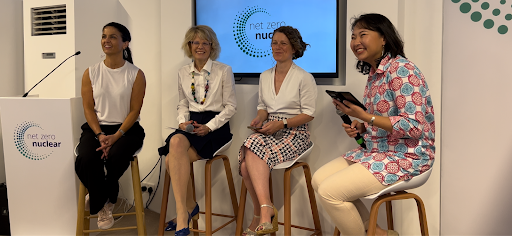Close
DUBAI - COP28 — December 5, 2023 — Small modular reactors (SMRs) are key to repurposing infrastructure at or near coal power plants. They provide a clean energy source that can be sited where needed, not where energy resources are available. Repurposing coal plants with nuclear energy provides several non-electricity-related benefits, including supporting the economy of small towns, reducing environmental and health impacts, providing higher wage jobs, and potential for related industries like hydrogen production.
Panelists Kirsty Gogan, Founding Director and Co-CEO of Terra Praxis; Kirsten Cutler, Senior Strategist for Nuclear Innovation, U.S. Department of State; and Christine John, Senior Manager, Indigenous Relations, Ontario Power Generation (OPG) engaged in a lively conversation on the topic at this year’s UN climate change conference (COP28). Dinara Ermakova, Ph.D., nuclear engineer and nuclear advocate, moderated the discussion.
John described Ontario’s successful coal phase-out involving OPG, Ontario’s Ministry of Energy, and the independent electricity system operator. “We were experiencing environmental smog days and issues with people’s health,” she said. “A lot of work went into building a strategy to phase out coal.”
Over 12 years, the province replaced the energy production of five coal plants with a mix of nuclear plant restarts, renewables, hydroelectricity, and some gas. “It required a collaborative approach, development of plans, being flexible to the ups and downs, and ultimately communicating what was being done, why it was being done, and what the ultimate outcome would be — and that is zero smog days in Ontario by 2014.”
Ermakova then asked Gogan about the impact on communities of the coal-to-nuclear transition. Gogan reinforced that coal is the single largest source of global carbon emissions. “Despite the success of building out renewables, coal is booming,” said Gogan. “The reason is that we need the energy. Particularly in developing economies that are densely populated, coal is a way of getting these economies out of poverty. Plus, the communities and societies around those coal plants need the socioeconomic benefits and jobs.”
What Terra Praxis is finding is that coal plant owners, utilities, and communities are interested in replacing the reliable, dispatchable energy that coal provides by co-locating nuclear plants at those existing sites to continue the jobs and socioeconomic benefits. “Utilities can continue to supply reliable energy and eliminate emissions at the same time,” she said. “Those are the immediate, fantastic benefits.”
Cutler weighed in on the U.S. government’s role in the coal-to-nuclear transition. “The Biden Administration has put climate action at the center of its foreign policy, and that includes nuclear energy as part of the solution to getting towards net zero,” she said. “And as part of that, the U.S. Department of State has ramped up its efforts in support of action internationally on supporting the deployment of both traditional large reactors as well as small and advanced nuclear power plants.”
The State Department also has increased the number of international instruments for nuclear cooperation, including signing a U.S. – Philippines agreement for cooperation on nuclear energy and ramping up foreign assistance and capacity building efforts. “So far, we’re partnered with over 20 countries. We have a team right now in Chile doing a regional project. That helps countries build up their nuclear power programs from the bottom up under the highest safety, security, and non-proliferation standards.”
In terms of coal-to-SMR conversions, she noted that the U.S. also launched Project Phoenix, a program that supports coal-to-SMR conversions that includes retaining and retraining local talent and jobs. The first three projects will be in The Czech Republic, Poland, and the Slovak Republic.
When asked what benefits SMRs can bring to remote communities, John noted that there are about 250 remote communities comprising up to 200,000 people in northern Ontario. They are not on the grid, so they rely primarily on massive amounts of diesel for electricity and heating. “The value of an SMR or a micro-modular nuclear reactor for these communities is immense,” she said.
Ermakova then asked Cutler about the policy changes required to help this transition happen. “The number one policy change I would advocate for is the financing piece,” said Cutler. “Right now, the World Bank and other multilateral development banks have a policy against supporting the building of new nuclear projects in the United States. Our Development Finance Corporation has revoked its prohibition against nuclear energy bills and we’re hoping that will set the stage for other banks and multilateral financing institutions to take action and see the clear need for supporting nuclear energy with financial resources.”
On the topic of other industries that can benefit from SMRs, Gogan said, “You can supply emissions-free steam from the nuclear island into the existing power island of the coal plant, reducing the schedule and cost.” She explained that standardization and the ability to design and license the nuclear island once and deliver it as a manufactured product is key to keep projects cost-effective and streamline pre-development activities. “There’s a huge appetite for emissions-free heat and power in a lot of other sectors as well, such as chemicals and steel,” she said.
Ermakova asked John about nuclear waste and environmental justice. “Over the 50-plus years that nuclear has been in operation in Ontario, the waste has been managed and stored and monitored without fail and without harm to the public and the environment.” She continued, “Not all waste is, in fact, waste. There are some very helpful byproducts, such as medical isotopes. And without medical isotopes, we would be lost as an entire global society.”
